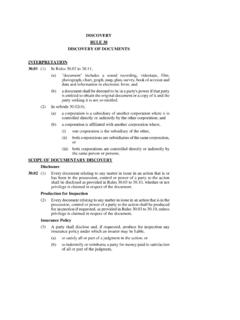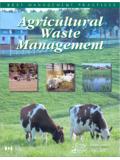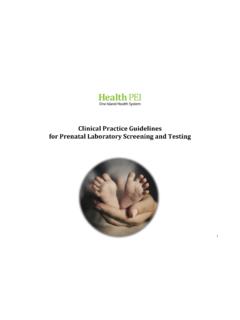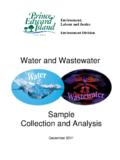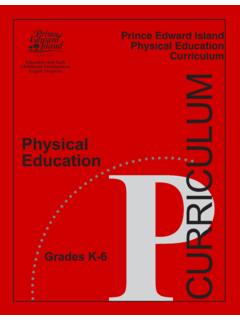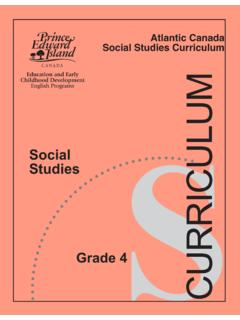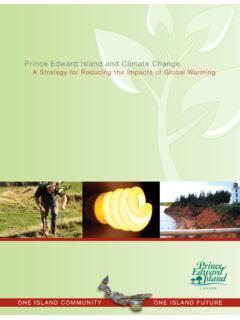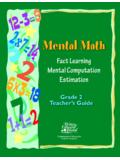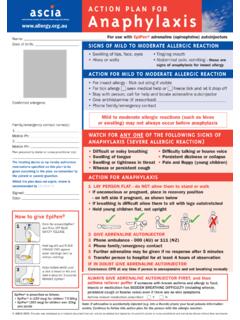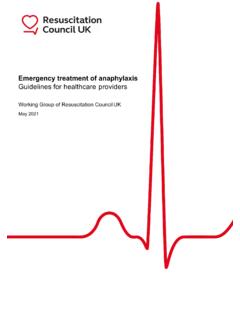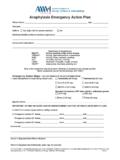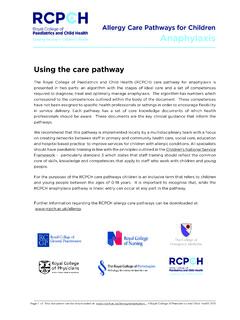Transcription of Physical Education Safety Guidelines, K-12
1 Safety Guidelines K-12 Physical EducationCurricularIntramuralInterschool 2010 Prince Edward IslandDepartment of Education andEarly Childhood Development250 Water Street, Suite 101 Summerside, Prince Edward IslandCanada, C1N 1B6 Tel. (902) 438-4130 Fax. (902) 438-4062 Guidelines K-12 CurricularPEI Department of Education and Early Childhood Development: Physical Education Safety GuidelinesiACKNOWLEDGEMENTSThe Department of Education and Early Childhood Development of Prince Edward Island gratefully acknowledges the contribution of the PhysicalEducation Safety Guidelines Committee in the development of this Boudreau, Bluefield High SchoolVelma Durant, cole vang lineRobyn MacDonald, Vernon River Consolidated SchoolJoan Moore, School Safety Consultant for the Provincial School BoardsPaul Steele, PEI School Athletic AssociationRick MacKinnon, PEI School Athletic AssociationCheryl Tanton, Somerset Elementary SchoolJohn Toner, Westisle Composite High SchoolLori MacPherson, Department of Education and Early Childhood DevelopmentThe Department of Education and Early Childhood Development and the Physical Education Safety Guidelines Committee would like to thankteachers, principals, school board personnel.
2 And the Risk Management and Insurance section of the Department of Finance and Municipal Affairs whoreviewed and gave input into this document prior to Department of Education and Early Childhood Development is also grateful to the province of Ontario for the initiative and production of theOntario Safety Guidelines. The document copyright was purchased from the Ontario Physical and Health Association (OPHEA) and was used as aworking base for the Prince Edward Island Safety document has three sections. There are Safety guidelines for: Physical Education curriculum; intramural sports programs; and interschool section has an guidelines have been developed to assist school boards in their formulation of site-specific Safety guidelines for Physical Education , intramural sportsprograms, and interschool athletics. These guidelines are, to the best of the Prince Edward Island Safety Guidelines Committee s knowledge, based upon themost current knowledge and experience available in Canada.
3 Implementation of Safety guidelines should in all cases be preceded by a close review of theseguidelines and appropriate modification on the part of each school board in order to meet the specific requirements and circumstances of their respective schoolsand programs. The Prince Edward Island Safety Guidelines Development Committee accepts no responsibility for the implementation and customization ofthese Department of Education and Early Childhood Development: Physical Education Safety GuidelinesiiTable of ContentsPhysical Education Safety GuidelinesCurricularGeneric SectionIntent of the and 1 Risk to Sport/Activity Page to the Activity Pull-out 1 3 Generic Safety 2 2 3 Ball Hockey/Cosom Hockey .. 2 4 2 5 Basketball/Bordenball/ 2 6 Board .. 28 Bowling/Lawn Bowling/Bocce 3 3 1 Climbing Ascending 3 2 Climbing 3 8 Climbing Climbing Wall and Climbing Related 4 3 Climbing Ropes/Challenge 5 0 Climbing Zipline/Tyrolean 5 7 Cricket/Cricket 6 2 Cross-Country 6 4 Cross-Country Skiing/Snow Shoeing/Snow 6 6 6 8 Dance/Rhythmic 7 0 Dodgeball/Tag Games.
4 7 1 Field 7 3 Fitness 7 4 Floor Hockey Gym Ringette .. 7 6 Football Flag/Touch .. 7 7 Football (Tackle).. 7 8 Golf .. 7 9 Gymnastics General 8 1 Gymnastics Above-ground 8 3 Gymnastics - 8 4 Gymnastics Bench and Chair 8 5 Gymnastics Box Horse/Utility Box .. 8 6 Gymnastics 8 7 Gymnastics Climbing Ropes .. 8 8 Gymnastics In-ground 8 9 Gymnastics Mat Work .. 9 1 Gymnastics 9 2 GymnasticsParallel Bars/Still Rings/Balance Beam/Uneven Parallel Bars//Vault Table/Flatback 9 3 Gymnastics Pyramid 9 9 6 PEI Department of Education and Early Childhood Development: Physical Education Safety GuidelinesiiiTable of ContentsPhysical Education Safety GuidelinesCurricularHockey (Ice) Lead up Games ( , shinny).. 9 7 Horseback Riding English/ 9 9In-Line Skating/Quad Roller 104 Lacrosse (Box/Field) .. 105 Lacrosse Inter (Soft) .. 107 Martial Arts Judo/Aikido/Karate/Tae-Kwan-Do.
5 108 Mountain 109 Movement Activities for Primary 113 Outdoor Education General 115 Outdoor Education 117 Outdoor Education 120 Outdoor Education Canoeing (Grades 7-12).. 123 Outdoor Education Canoeing Moving Water (Grades 7-12).. 127 Outdoor Education Flat Water Kayaking (Grades 7-12).. 131 Outdoor Education Ropes Courses/Rappel 134 Outdoor Education Rock 137 Outdoor Education Sailing .. 141 Outdoor Education Swimming Lakes/ 144 Outdoor Education Winter Tent Camping .. 151 Paddle 157 Ringette - 158 Rugby 160 Rugby 161 Scoop 162 Scooter 163 Self Defense .. 165 Skating - Ice .. 167 Skiing Alpine/ 171 Snow 172 Soccer/Crab-Soccer/Soccer-Baseball 174 Softball 176 Softball Lob-Ball/Slo- 177 Softball Lead-up games:Soccer-Baseball/Volley- 181 Swimming/Synchronized Swimming - 182 Table Tennis .. 185 Team 188 189 Yoga.
6 191 PEI Department of Education and Early Childhood Development: Physical Education Safety GuidelinesivTable of ContentsPhysical Education Safety GuidelinesCurricularTrack and Field 192 Track and Field High Jump .. 194 Track and Field Hurdles .. 196 Track and Field 197 Track and Field Pole Vault .. 198 Track and Field Shot Put .. 199 Track and Field Track EventsSprints and 201 Track and Field Triple Jump/Long Jump .. 203 Tug of War .. 205 Ultimate 208 Volleyball 211 Weight 212 White Water 214 Wrestling .. 215 Appendix A - Sample Letter to Parents/Guardians .. 219 Appendix B - Sample First Aid 221 Appendix C - emergency Action 222 Appendix D-1 Physical Activity andSport-Related 224 Appendix D-2 Sample Request to ResumePhysical Education Concussion - Related 228 Appendix E - Lightning 230 Appendix F - Safety in Activity 232 Appendix G - Newly-Purchased or DonatedFitness 233 Appendix H-1 - Sample Safety Checklist Gymnasium 234 Appendix H-2 - Sample Safety Checklist Gymnasium 239 Appendix H-3 - Sample Safety Checklist Outside 244 Appendix I - Students 247 Appendix J - Universal Precautions Blood and Body 248 Appendix K - Water 249 PEI Department of Education and Early Childhood Development: Physical Education Safety Guidelines1 Physical Education Safety GuidelinesCurricularGeneric SectionIntent of the Physical Education Safety Guidelines.
7 The primary responsibility for the care and Safety of students rests with the school board and its employees. An important aspect in fulfilling this role isto recognize that there is an element of risk in all Physical activity and to take action accordingly. To this end, foreseeable risks have been identified andanalyzed. These guidelines include procedures that help minimize, to the greatest extent possible, the risk of a preventable accident or injury. A guidelinealone does not eliminate risk regardless of how well it is written or how effectively it is implemented. Safety awareness, practised by the teacher, based onup-to-date information, common sense observation, action, and foresight, is the key to safe programming. The intent of the Curricular Safety Guidelinesis to focus the teacher s attention on safe instructional practices for each class activity in order to minimize the inherent element of risk.
8 By implementingsafe instructional practices, such as use of logical teaching progressions, as well as inclusion of age-appropriate activities in program preparations, planningand daily teaching, the educator will guard against foreseeable risks. It is hoped that through this implementation process, this document will assisteducators in fulfilling their obligation to provide the safest possible environment in which all students, regardless of Physical , mental, emotional abilities/challenges or cultural background, can be physically and Scope of this document:The Safety Guidelines statements are mandatory. An activity must not occur unless these statements have been document delineates minimum guidelines that must be met by Physical educators and administrators in addressing the Safety component of thephysical Education core program. This module focuses on classroom instruction in Physical Education .
9 Intramural and interschool activity guidelines canbe found in the second and third Department of Education and Early Childhood Development: Physical Education Safety Guidelines2 Physical Education Safety GuidelinesCurricularGeneric SectionRisk ManagementThe following elements of risk must be taken into consideration by the teacher: The activity is age-appropriate for the students Physical /mental abilities and behavioural patterns. The teacher has the knowledge and ability in accordance with the Safety guideline pages to teach/supervise the activity safely. When considering an activity which is not addressed in the Physical Education curriculum or the Prince Edward Island PhysicalEducation Safety Guidelines, the educational value vs. the entertainment value of the activity must be determined ( , Is going to awave pool educational or entertainment?). Once the activity has been approved as having educational value, the inherent risks mustbe identified and Department of Education and Early Childhood Development: Physical Education Safety Guidelines3 Physical Education Safety GuidelinesCurricularGeneric SectionA.
10 Generic IssuesPlease Note: the following guideline statements are not listed in any order of priority lists of examples in these guidelines are not exclusive all guideline statements are mandatoryThere are many common guidelines for Safety which apply to all class activities. Some commonalities the beginning of the school year, teachers need to be aware of the medical background and Physical limitations of their includes knowledge of students with heart disorders, asthma, diabetes, severe allergies, anaphylaxis , etc. Each school needs todevelop a process by which medical information is available to teachers, , a process is developed where medical information iscommunicated to all relevant teachers, at the beginning of the school year and throughout the year as needed. (see Appendix A).For students with medical conditions ( , asthma, life threatening allergies, diabetes, etc.)
